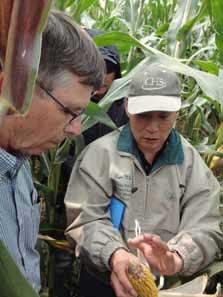If one of the heads cracks on your combine during harvest, you expect to talk directly with your dealer. When you need the best advice on seed, the trust built over the years goes beyond the brand name. Deals are still made with a handshake on the tailgate of a pickup truck.
Face-to-face. That’s the way business is done in agriculture.
To successfully move grains over oceans and half a world away, the business of exporting U.S. grains requires that personal attention. Just this past week, the U.S. Grains Council brought personal attention into practice with overseas travel to meet Japanese and Chinese grain importers and government officials. Where regulations and rule books can make exports a difficult path to understand, these face to face meetings provide the map and the means to sell your corn, wheat, barley, oats and sorghum into overseas markets.
In Japan, USGC Chairman Terry Vinduska, Treasurer Don Fast and Trade Policy Director Floyd Gaibler made clear that food security and the quality of feed depend on the transparency of both the buyer and seller understanding government standards and regulations. Japanese grain importers and their end-users welcomed the Council’s help in having Japan’s regulators understand how highly restrictive levels imposed on mycotoxins can be harmonized with U.S. standards based on sound, international scientific standards. Emphasizing the United States’ reliability as primary supplier of grains for feed and food use, the Council’s role served to address misunderstandings and facilitate the direct exchange of information between scientists and regulators in both Japan and the United States. These meetings with both industry and regulators confirmed the need for effective scientific exchanges to enhance trade relationships.
China’s growing demand for U.S. grains is becoming more apparent as demonstrated by the Council’s on-site discussions with China’s leading importers of corn, American sellers of seed, and the Council’s own survey of corn fields. The Council Chairman’s Mission to China addressed head-on some Chinese industry concerns on U.S. corn availability. Council analysis projects continued strong corn yields that will easily accommodate future ethanol production in the United States. This will enable corn producers to sell more overseas as yield projections in 10 years will increase rapidly with the adoption of planned biotechnology events that continue to improve plant efficiencies. As China scrutinizes corn co-product DDGS, the Council is putting in place the means to provide industry and government-required information needed for time-effective review of this high-protein feed source.
Japan and China view the United States as a reliable supplier of their grain needs for their own food security. Transparency of quality and safety requirements is the key to this food security. America’s role as their reliable supplier also involves Japan and China as reliable buyers with continued, positive collaboration that benefits both sides of the grains transaction.


